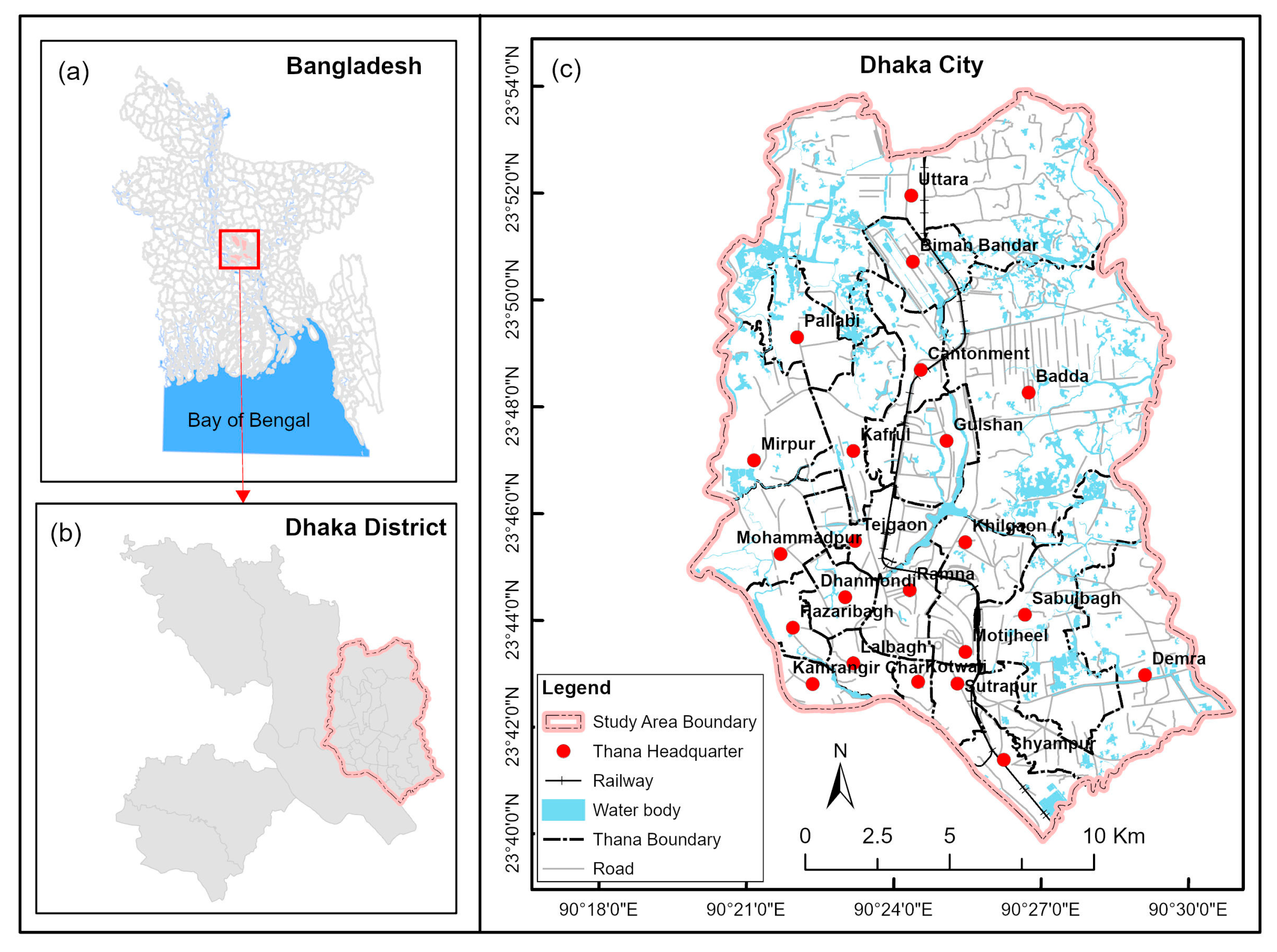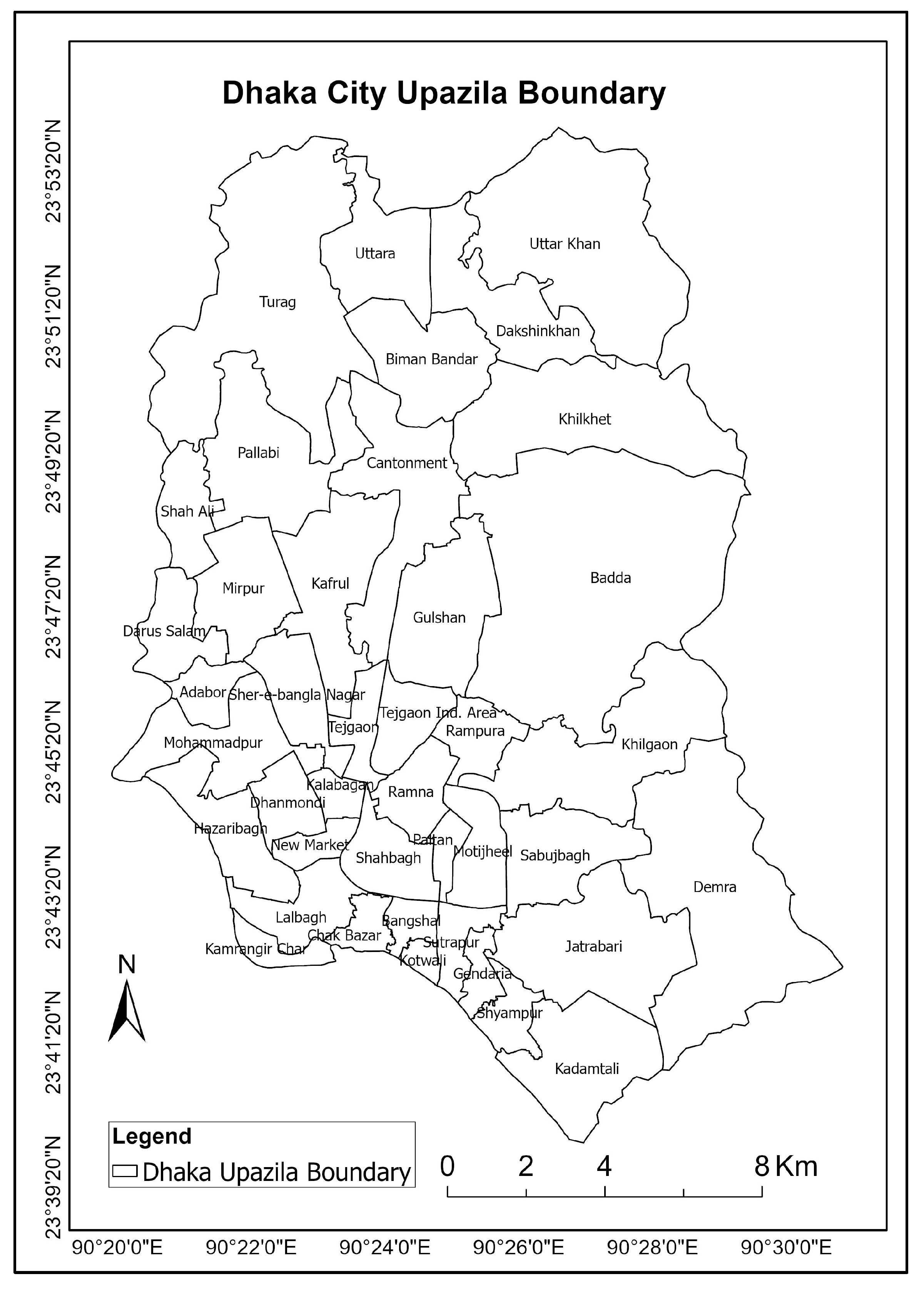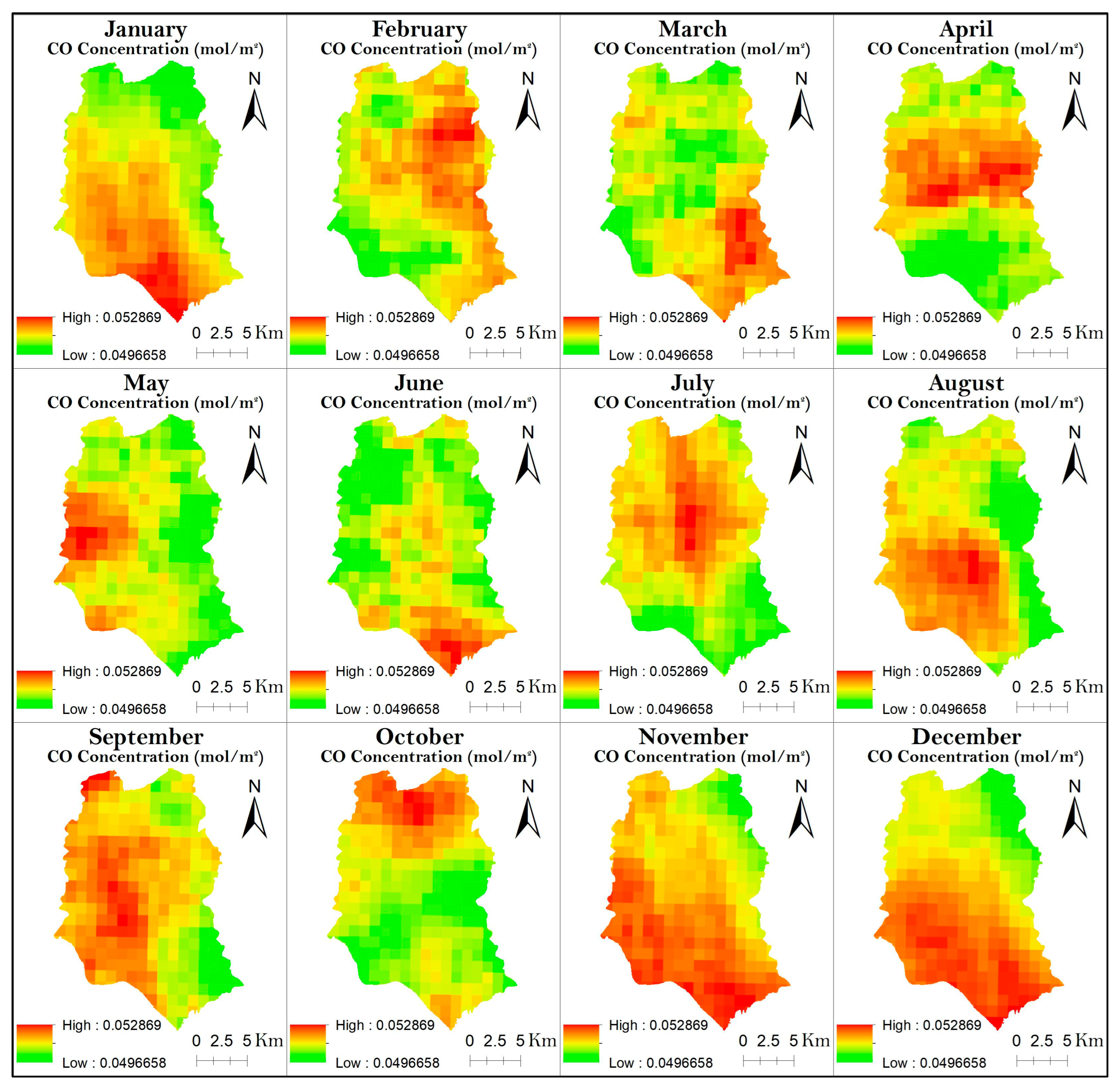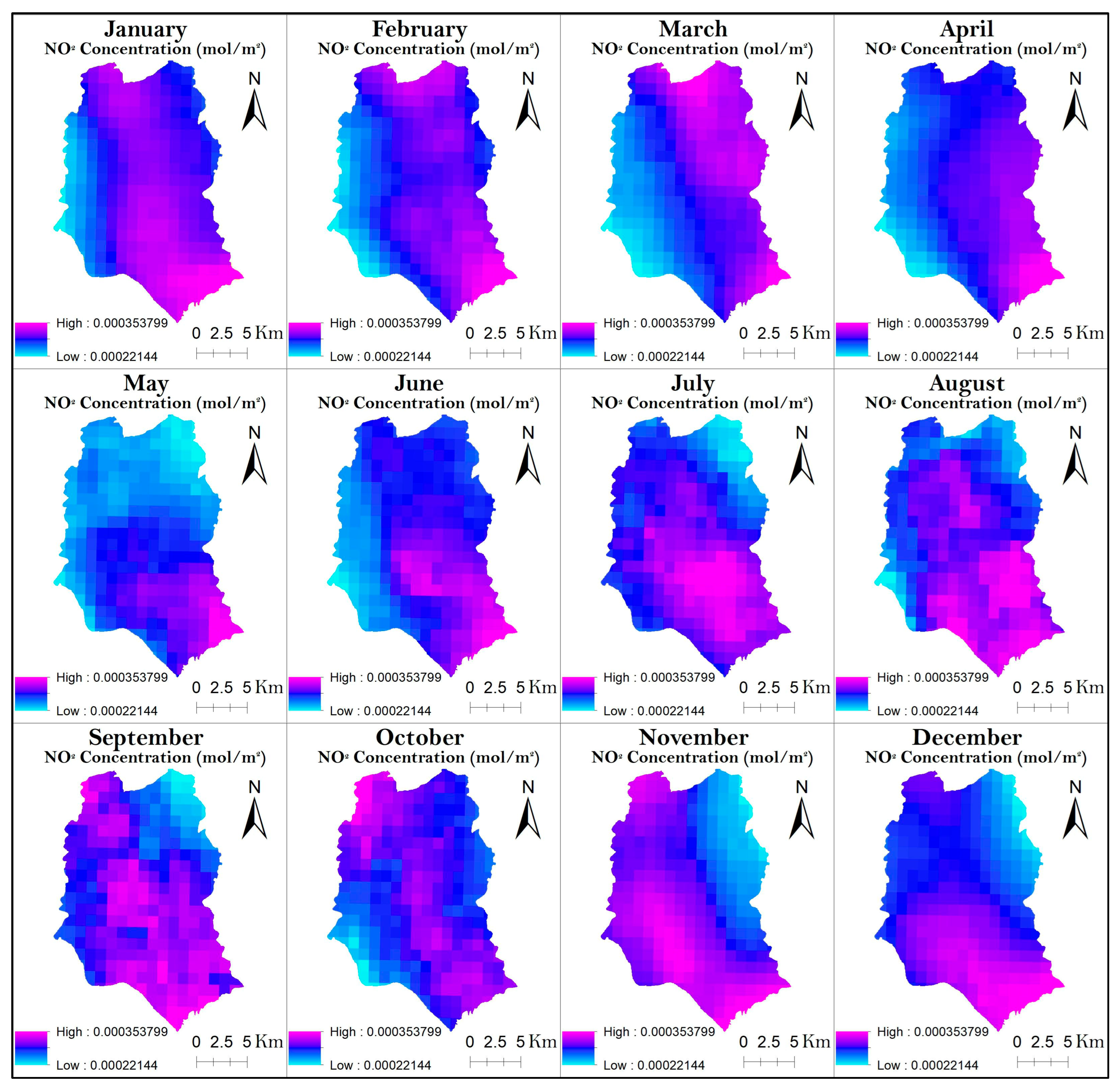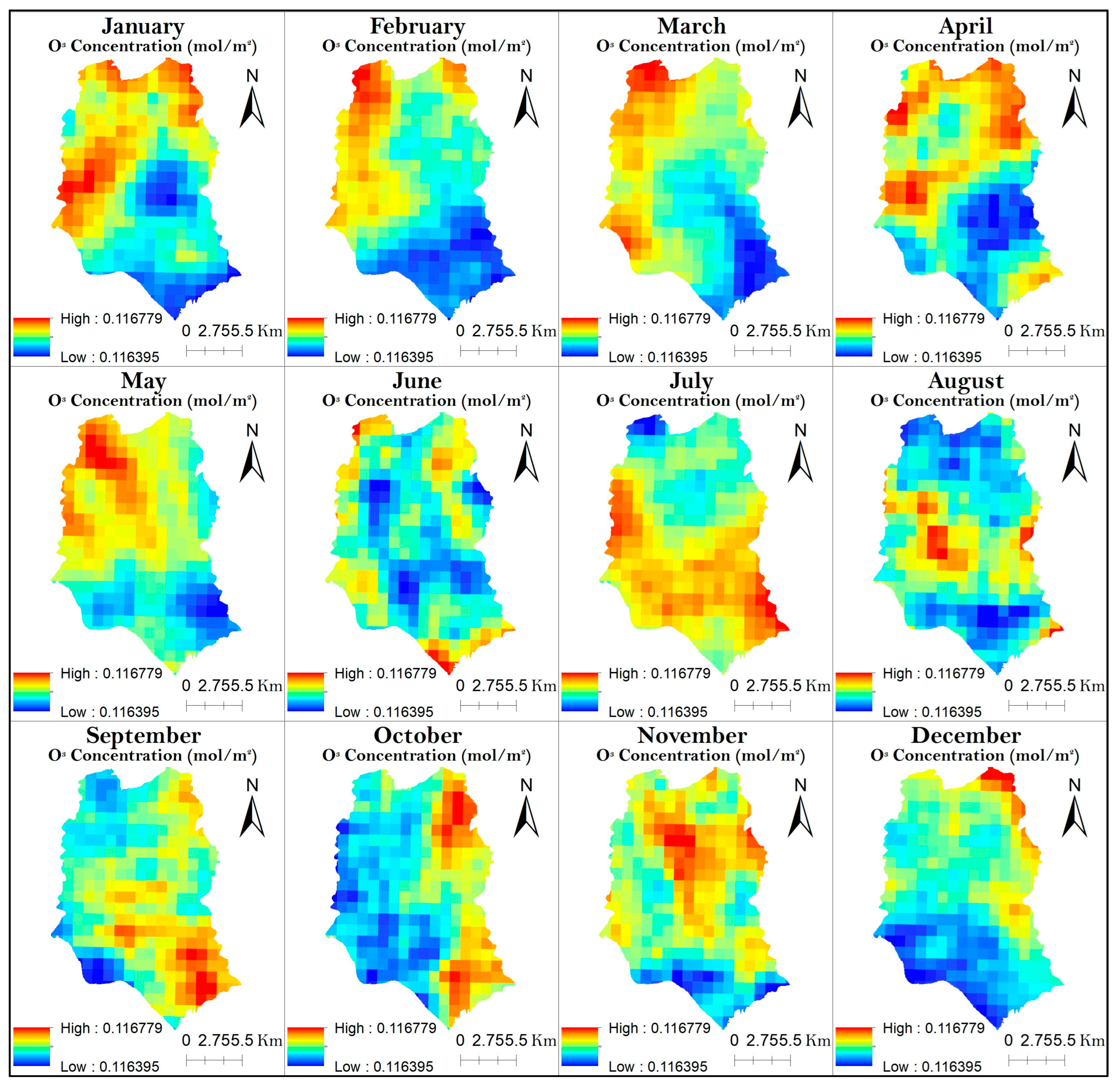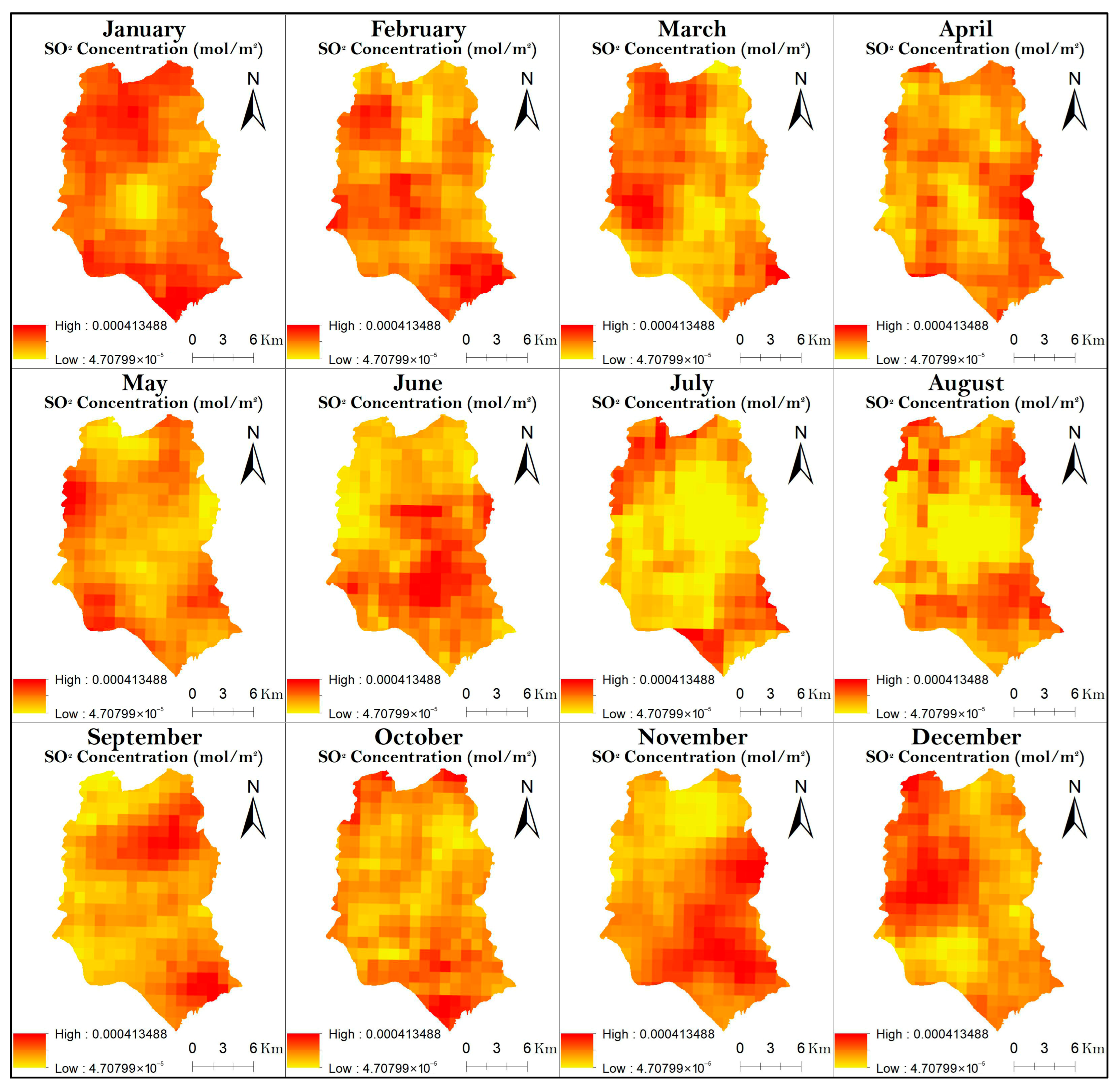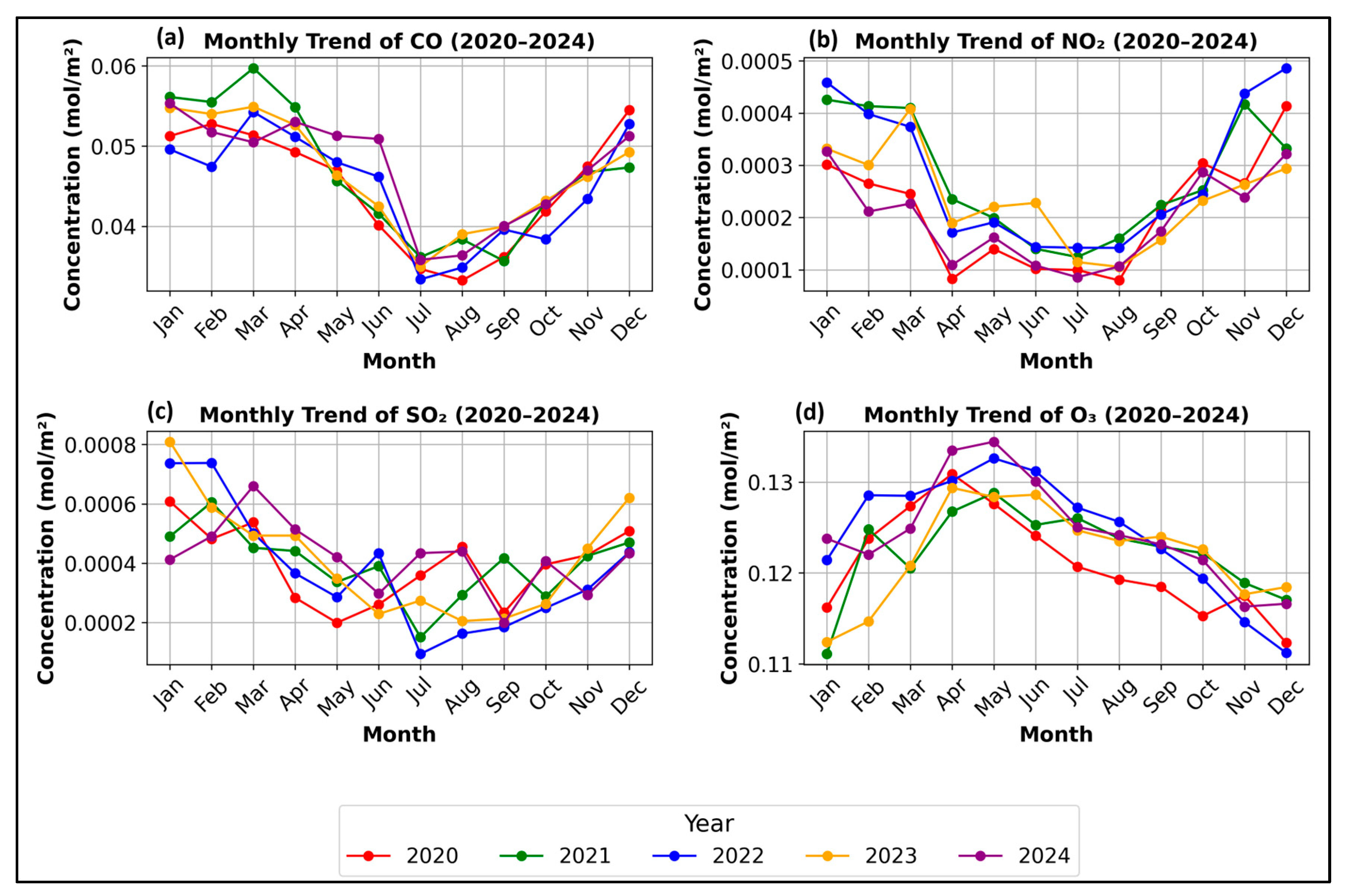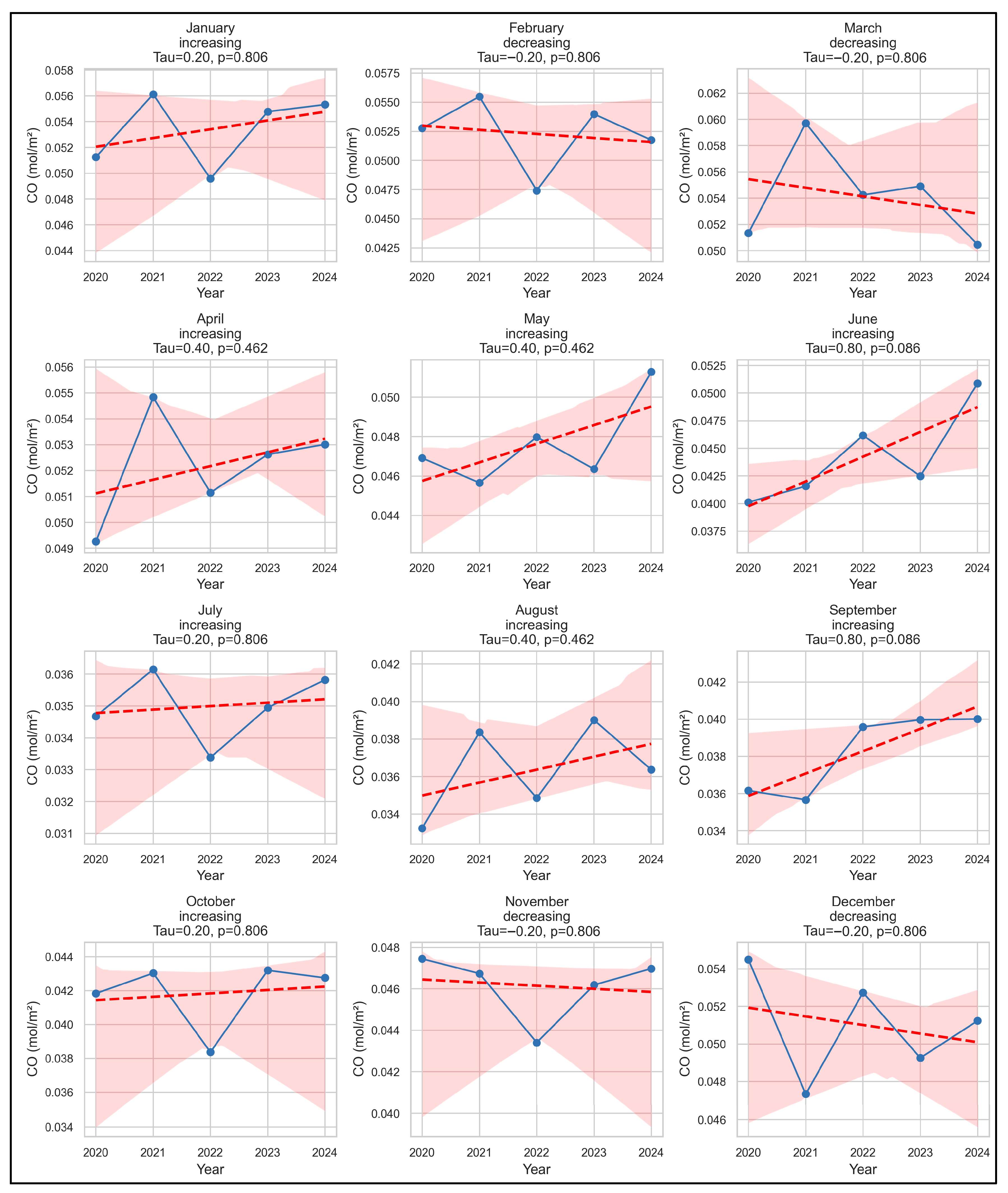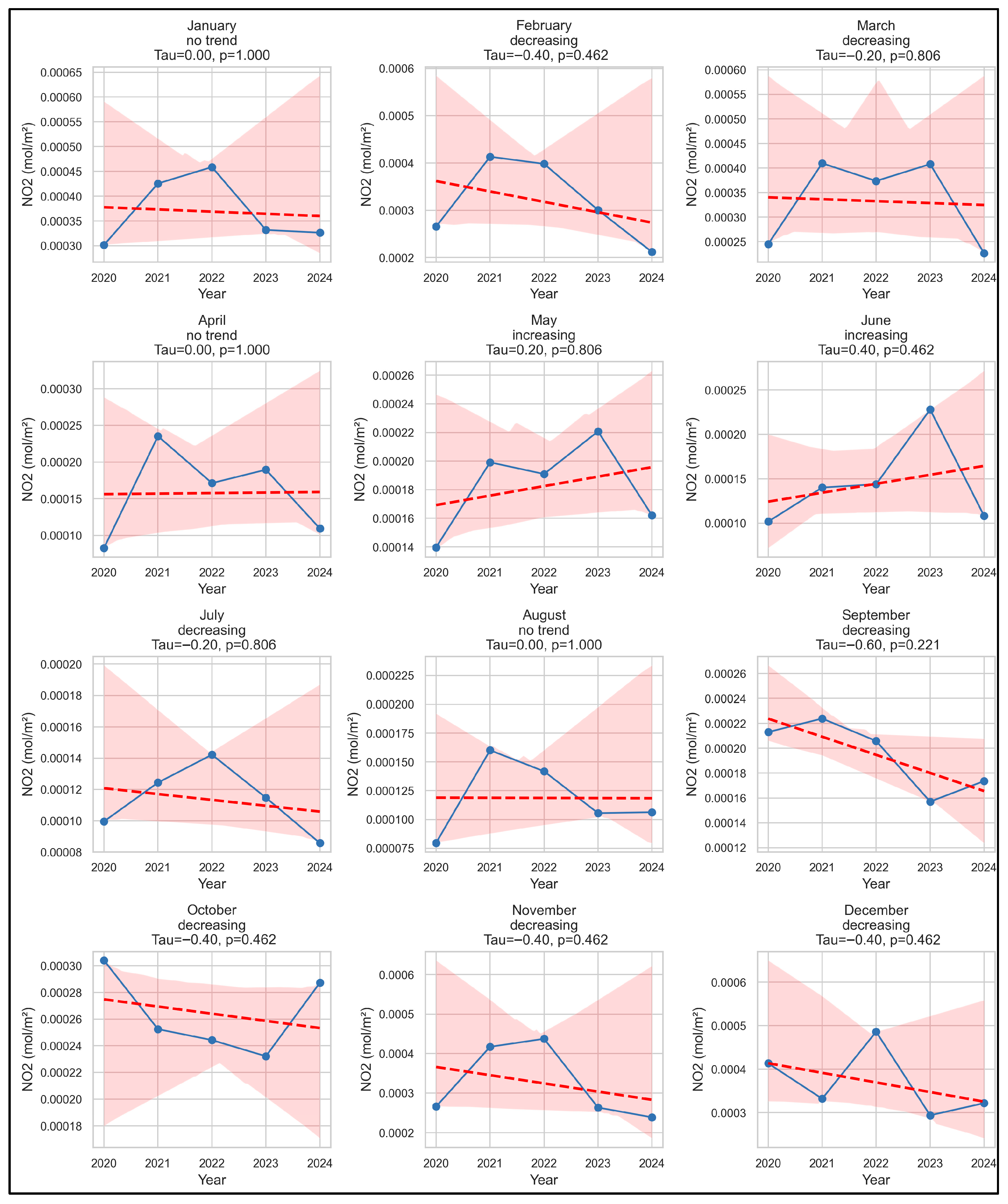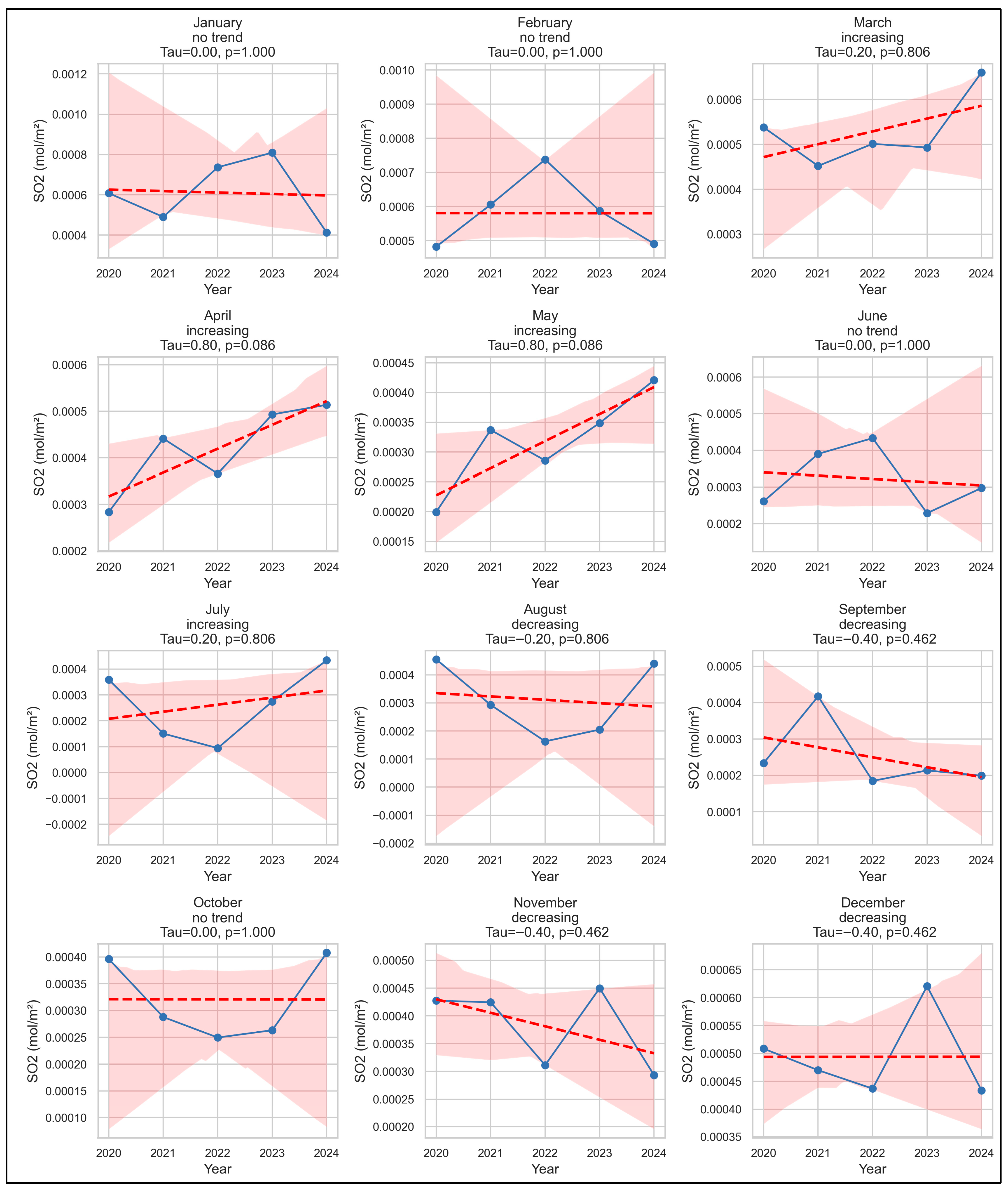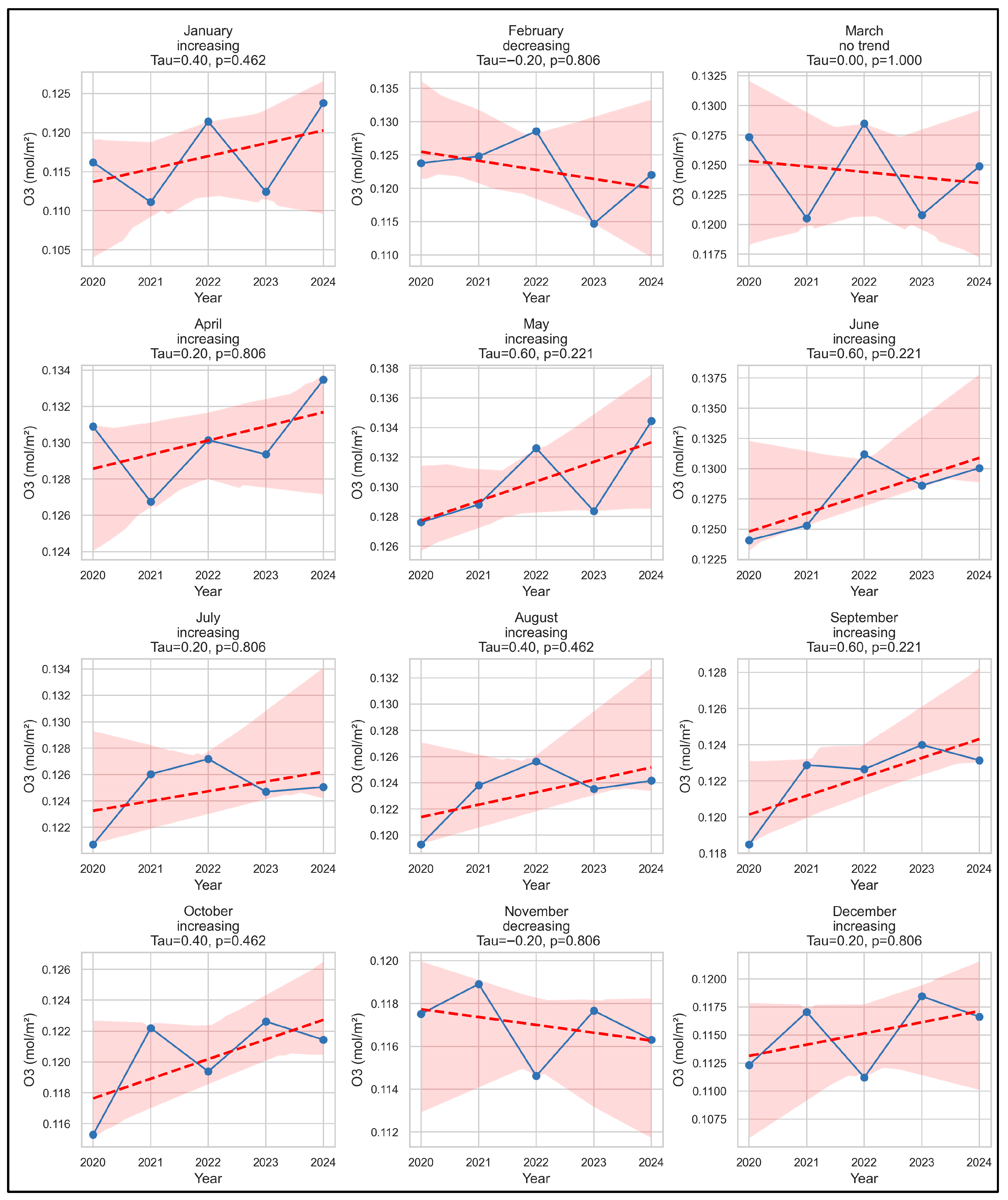1. Introduction
Air pollution has emerged as one of the most pressing environmental and public health challenges of the 21st century, particularly in densely populated and rapidly urbanising cities in the Global South. The World Health Organisation (WHO) estimates that air pollution contributes to approximately 7 million premature deaths globally each year, with urban populations facing disproportionately high exposure to harmful pollutants [
1]. Among the most critical urban air pollutants are carbon monoxide (CO), nitrogen dioxide (NO
2), sulphur dioxide (SO
2), and ground-level ozone (O
3), each of which poses unique risks to human health, ecosystems, and the climate [
2,
3]. These pollutants are primarily emitted from anthropogenic sources, including vehicular exhaust, industrial activities, fossil fuel combustion, and biomass burning [
4]. As cities continue to grow, understanding the spatiotemporal dynamics of these pollutants becomes essential for effective environmental governance and sustainable urban planning.
In South Asia, Bangladesh—particularly its capital, Dhaka—has been identified as one of the cities with the worst air quality in the world [
5]. Dhaka’s complex urban structure, high population density, unregulated industrial clusters, and chronic traffic congestion contribute to persistent and often severe air pollution episodes. Despite growing public concern, monitoring air quality in Dhaka has been hampered by limitations in ground-based sensor networks, including sparse spatial coverage, inconsistent data availability, and maintenance issues [
6,
7]. These limitations necessitate the integration of satellite remote sensing technologies for continuous, consistent, and large-scale monitoring of atmospheric pollutants.
In recent years, the launch of the European Space Agency’s Sentinel-5P satellite—equipped with the TROPOspheric Monitoring Instrument (TROPOMI)—has revolutionised atmospheric monitoring by providing high-resolution, near-real-time data on key trace gases at a global scale [
8]. Sentinel-5P offers daily coverage and spatial granularity sufficient to detect intra-urban pollution variations, making it especially valuable for cities like Dhaka. Coupled with cloud-based geospatial platforms such as Google Earth Engine (GEE), which enables large-scale environmental data processing, researchers now have powerful tools to assess both the spatial and temporal patterns of air pollutants with unprecedented detail and continuity [
9].
Several studies have investigated air pollution in Dhaka, with a primary focus on particulate matter (PM) and localised pollutant measurements. For example, Begum et al. [
10] and Salam et al. [
11] conducted ground-based assessments of PM
2.5 and PM
10, identifying major emission sources such as vehicular exhaust, brick kilns, and biomass combustion. Noman et al. [
12] used low-cost sensor networks to explore spatial patterns of PM
2.5 and PM
10 within Dhaka’s urban core, while Kudrat-E-Khuda [
13] assessed roadside air pollution and its impact on public health. Although these studies provide valuable insights, they are constrained by limited spatial and temporal coverage and are heavily dependent on sparse ground monitoring networks.
In contrast, satellite-based remote sensing offers consistent, large-scale coverage that can reveal both spatial and temporal variations in atmospheric pollutants—an advantage particularly relevant for cities like Dhaka, where ground-based observations are limited. Across Asia and globally, researchers have increasingly used Sentinel-5P and other satellite platforms to monitor urban air quality. For instance, Bauwens et al. [
14] investigated the impacts of activity reductions resulting from the spread of COVID-19 on NO2 levels in China, South Korea, Italy, Spain, France, Germany, Iran, and the United States, and Matandirotya et al. [
15] used TROPOMI to assess NO
2 dynamics over four megacities in Southern Africa region. However, in Bangladesh, the use of satellite imagery for long-term air quality monitoring remains relatively underdeveloped. Existing studies using satellite data in Dhaka are often short-term and pollutant-specific—such as Rana et al. [
16], who examined NO
2 during the COVID-19 lockdown, or Shobnom et al. [
17], who assessed spatiotemporal variation in only NO
2 variations.
To date, there is a notable lack of comprehensive studies that analyse the spatiotemporal dynamics of multiple air pollutants over Dhaka using high-resolution satellite data. This study addresses this gap. The present study aims to monitor and analyse the spatiotemporal dynamics of four major urban air pollutants—CO, NO2, SO2, and O3—over Dhaka using Sentinel-5P satellite data processed through Google Earth Engine. By constructing a continuous 60-month (January 2020–December 2024) time-series of monthly pollutant concentrations, this research provides one of the most comprehensive assessments of long-term air pollution trends in Dhaka to date.
This research contributes to the growing body of work on satellite-based air quality monitoring by providing a detailed, multi-pollutant assessment of Dhaka’s atmospheric environment. The study reveals emerging seasonal patterns, potential pollution hotspots, and trend directions for each pollutant, offering valuable information for policymakers, urban planners, and public health officials. By linking satellite-based insights with urban management goals, the findings underscore the potential for remote sensing and cloud computing to support data-driven environmental governance in rapidly growing cities of the Global South.
It should also be noted that the satellite-derived column concentrations provide integrated values across the atmospheric column and do not directly represent surface-level exposure. Estimation of µg/m3 would require additional vertical distribution modelling or ground-based calibration, which is outside the scope of this spatiotemporal assessment.
The paper is structured as follows.
Section 2 outlines the materials and methods, detailing the study area, data sources, satellite processing in Google Earth Engine (GEE), spatial analysis in ArcGIS Pro, Python-based automation, and the application of the Mann–Kendall trend test.
Section 3 presents the results, including temporal and seasonal pollutant variations, interannual trends, spatial distributions, and statistical trend assessments.
Section 4 provides an in-depth discussion of the observed patterns, highlighting their meteorological, anthropogenic, and spatial drivers. This section also explores the policy implications of the findings, emphasising targeted interventions for urban air quality management. Finally,
Section 5 concludes the study by summarising the key insights and offering recommendations for integrating satellite-based air quality assessments into evidence-driven urban planning.
2. Materials and Methods
We employed a multi-platform geospatial and remote sensing approach to examine the spatiotemporal variations in key urban air pollutants over Dhaka from January 2020 to December 2024. Our methodological framework integrated satellite-based atmospheric data, cloud-based remote sensing processing, desktop GIS analysis, and Python-based automation to extract, analyse, and visualise monthly and seasonal patterns of carbon monoxide (CO), nitrogen dioxide (NO2), sulphur dioxide (SO2), and ozone (O3). The entire workflow consisted of several interlinked stages, including study area delineation, data acquisition and preprocessing, time-series pollutant derivation in Google Earth Engine (GEE), and spatial mapping and analysis in ArcGIS Pro 3.1.0.
2.1. Study Area
This study focused on Dhaka, the capital and largest urban centre of Bangladesh, which is recognised as one of the most densely populated and polluted cities globally [
18]. We delineated the study boundary using an administrative shapefile of Dhaka, obtained from the Bangladesh Bureau of Statistics (BBS), representing the Dhaka City Corporation area. The shapefile was projected to WGS 84 UTM 46 N and used as a consistent clipping mask throughout our processing. The spatial extent of the study area ranged approximately from 23.67° N to 23.90° N latitude and from 90.33° E to 90.51° E longitude and has an area of 305.82 km
2. The area is characterised by dense urban infrastructure, high traffic emissions, and rapid industrialisation—factors contributing significantly to air quality deterioration.
Figure 1 and
Figure 2 show the location and upazila (upazila is the level 3 administrative boundary in Bangladesh) boundary of the study area, respectively.
Dhaka has a tropical wet and dry climate, characterised by hot, humid conditions and a distinct monsoon season. Temperatures generally range from 18 °C (64 °F) in January to 29 °C (84 °F) in August, with an annual average of 25 °C (77 °F). The rainy season, influenced by monsoons, typically occurs from April to September, with June seeing the heaviest rainfall. The driest period is from November to March [
19].
The air and water in Dhaka are becoming more polluted due to the city’s constantly growing population. To meet the demands of the growing population, multistorey buildings and real estate developments are taking up wetland and green space, endangering the city’s biodiversity and urban ecosystem [
20].
2.2. Data Sources and Acquisition
We utilised Level 3 (L3) tropospheric column concentration products from the Sentinel-5 Precursor (Sentinel-5P) satellite, which is equipped with the Tropospheric Monitoring Instrument (TROPOMI). This instrument provides daily global measurements of several atmospheric pollutants at a spatial resolution of up to 7 × 3.5 km
2 (after August 2019), making it suitable for urban-scale air quality analysis [
8]. The pollutant-specific datasets used were as follows:
CO: COPERNICUS/S5P/OFFL/L3_CO;
NO2: COPERNICUS/S5P/OFFL/L3_NO2;
SO2: COPERNICUS/S5P/OFFL/L3_SO2;
O3: COPERNICUS/S5P/OFFL/L3_O3.
We accessed and processed these datasets directly from the Google Earth Engine (GEE) platform, which offers high-performance cloud-based geospatial computation and analysis tools. In total, 60 months of data were acquired and analysed for each pollutant, covering January 2020 to December 2024. Additionally, we used auxiliary data including Dhaka’s administrative boundary and OpenStreetMap (OSM) layers for contextual mapping.
2.3. Data Processing in Google Earth Engine
All pollutant-specific atmospheric datasets were processed using JavaScript in the GEE code editor. We filtered the Sentinel-5P datasets temporally and spatially to extract pollutant concentrations over Dhaka monthly. Each ImageCollection was filtered using the ee.Filter.date() function to isolate data for each month. Spatially, we applied the .clip() function using the Dhaka shapefile to confine the dataset to our study boundary.
To ensure the quality and reliability of satellite-derived measurements, we applied a quality assurance (QA) filtering step for each dataset. We applied a quality assurance threshold of QA > 0.75 to filter out low-quality retrievals, following established practice in TROPOMI NO
2 and SO
2 studies [
21,
22,
23,
24]. This threshold effectively removes pixels affected by clouds, snow/ice, and retrieval noise, ensuring high-confidence data for spatial and temporal analyses.
Monthly mean composites were generated using the ImageCollection.mean() function in GEE. These monthly average images were then exported in GeoTIFF format to Google Drive using the Export.image.toDrive() function, with a resolution of 0.01 degrees (~1 km) and a bounding box matching the extent of Dhaka. We developed a modular and reusable GEE script that looped through each month and pollutant type to automate the composite generation and export process. This significantly reduced processing time and ensured consistency across the 60-month dataset.
2.4. Spatial Analysis and Visualisation in ArcGIS Pro
We performed the spatial analysis and visualisation of pollutant data using ArcGIS Pro 3.x, which served as the principal desktop GIS platform for integrating, processing, and interpreting the Sentinel-5P-derived outputs. After exporting the monthly raster layers for CO, NO2, SO2, and O3 from Google Earth Engine (GEE) as GeoTIFF files, we imported these into ArcGIS Pro and organised them systematically in raster catalogues corresponding to each pollutant. This structured organisation facilitated batch processing, visualisation, and temporal analysis of the 60 monthly rasters (January 2020–December 2024) for each pollutant.
We also generated annual and seasonal average maps by performing raster algebra operations using the “Raster Calculator” tool. Monthly rasters were grouped by year or season (i.e., winter, pre-monsoon, monsoon, and post-monsoon) and averaged to create composite layers representing intra-annual variability. These composites were crucial for identifying persistent pollution zones and for comparing spatial distribution changes over the years.
To support time-series visualisation, we used the “Time Slider” tool in ArcGIS Pro. We assigned timestamps to each raster layer and created spatiotemporal animations to illustrate the dynamic monthly changes in pollutant distribution. This technique enabled an intuitive understanding of pollutant behaviour and seasonality across years.
2.5. Python-Based Automation Within ArcGIS Pro
To streamline repetitive tasks such as map production, data export, and temporal plotting, we implemented Python scripting through ArcGIS Pro’s built-in Jupyter Notebook 3.9.16 environment. Using the ArcPy module, we automated tasks including the following:
Batch map generation with consistent layouts (legend, north arrow, scale bar, title);
Exporting raster statistics to CSV files for each month and pollutant;
Plotting pollutant trends over time using matplotlib and pandas;
Performing raster calculations (e.g., difference maps between years).
This automation significantly improved the efficiency of our workflow and reduced the likelihood of human error in processing large volumes of spatial data.
2.6. Temporal Trend and Seasonal Analysis
To capture temporal variability, we categorised each month into four major seasons typical of South Asian monsoonal climates: Winter (December–February), Pre-monsoon (March–May), Monsoon (June–September), and Post-monsoon (October–November) [
25]. For each season, we computed seasonal mean composites by averaging the monthly raster layers within each seasonal group. Annual means were also computed by averaging all 12 monthly composites for each year from 2020 to 2024. The resulting seasonal and yearly rasters were used to analyse intra-annual fluctuations and interannual trends in pollutant levels.
We further calculated per cent changes in annual pollutant concentrations using raster algebra functions. Trend analysis graphs were generated using time-series data exported from zonal statistics, helping to visualise upward or downward trends across the study period.
2.7. Monthly Trend Detection Using Mann–Kendall Test
To statistically assess monotonic trends in pollutant concentrations over time, we conducted the non-parametric Mann–Kendall (MK) trend test on the monthly average values of CO, NO
2, SO
2, and O
3 for the 60-month period (January 2020 to December 2024). The Mann–Kendall test is widely used in environmental time-series analysis due to its robustness to missing data, non-normal distributions, and its ability to detect both increasing and decreasing trends without assuming linearity [
26,
27,
28].
For each pollutant, we extracted monthly mean concentration values for the entire city of Dhaka using the “Zonal Statistics as Table” tool in ArcGIS Pro. The output tables were exported as CSV files and processed in Python using the pymannkendall package, which implements the original Mann–Kendall test along with the modified versions for seasonality and serial correlation correction.
The test was applied to the time-series for each pollutant, yielding the Kendall’s Tau coefficient, p-value, and trend classification (increasing, decreasing, or no trend). A significance level of α = 0.05 was adopted to determine whether the observed trend was statistically significant. This step allowed us to quantitatively evaluate long-term changes in atmospheric pollutant concentrations and validate observed patterns in the spatiotemporal maps.
The Mann–Kendall results were then integrated with the spatial analysis by visualising the statistically significant trends alongside mapped changes in pollutant concentrations. This combination of visual and statistical trend assessment enabled a more comprehensive interpretation of urban air quality dynamics in Dhaka.
3. Results
This section presents the findings of the spatiotemporal analysis of four key atmospheric pollutants—carbon monoxide (CO), nitrogen dioxide (NO2), sulphur dioxide (SO2), and ozone (O3)—over Dhaka from January 2020 to December 2024. The results are organised to highlight both temporal and spatial patterns, including monthly and seasonal variations, interannual trends, and statistically assessed changes using the Mann–Kendall trend test. Furthermore, spatial distribution maps and zone-wise comparisons reveal intra-urban pollution hotspots and potential source-attribution patterns. All the findings are derived from Sentinel-5P TROPOMI satellite data processed through Google Earth Engine and analysed in ArcGIS Pro, ensuring consistency and high-resolution coverage across the 60-month study period. The results are reported in mol/m2, and pollutant-specific characteristics are examined to uncover both meteorological and anthropogenic influences on air quality dynamics in Dhaka.
3.1. Temporal Variation in Pollutants (2020–2024)
3.1.1. Carbon Monoxide (CO)
The monthly mean CO concentrations over Dhaka displayed a distinct seasonal pattern, peaking during winter and declining through the summer monsoon (
Figure 3). January recorded the highest mean (0.05136 mol/m
2), with the maximum concentration reaching 0.05287 mol/m
2 and the mode at 0.05195 mol/m
2. In contrast, July presented the lowest mean (0.03364 mol/m
2), minimum (0.03279 mol/m
2), and mode (0.03345 mol/m
2). According to
Table A1 in
Appendix A, the standard deviation was highest in January (0.00064), indicating greater variability during colder months, while June–September had the lowest standard deviations (approx. 0.00029–0.00033), reflecting more stable pollutant levels.
3.1.2. Nitrogen Dioxide (NO2)
Monthly average NO
2 concentration (2020–2024) in Dhaka has been presented in
Figure 4. NO
2 also exhibited pronounced winter peaks and summer lows. January and December had the highest means (0.00030 and 0.00029 mol/m
2, respectively), with corresponding maxima (0.00035 and 0.00035 mol/m
2). July marked the lowest average concentration (0.000081 mol/m
2) and showed the smallest standard deviation (0.000010), suggesting uniformly low NO
2 levels during monsoon months. According to
Table A1 in
Appendix A, the highest variability occurred in March and November (standard deviations: ~0.000030), suggesting increased fluctuation in emissions during seasonal transitions.
3.1.3. Ozone (O3)
O
3 concentrations exhibited an inverse seasonal pattern. According to
Figure 5, the mean was highest in May (0.13004 mol/m
2) and lowest in December (0.11476 mol/m
2). Maximum values peaked in May (0.13023 mol/m
2) and minimums were lowest in January (0.11639 mol/m
2). The lowest standard deviation was recorded in June (0.000045), showing remarkably consistent levels during early monsoon. According to
Table A1 in
Appendix A, mode values across all months closely aligned with mean values, indicating normally distributed data and low skewness in O
3 concentrations.
Ozone exhibits a complex vertical profile due to its photochemical formation and downward transport from higher altitudes. Satellite-derived total column ozone may differ from concentrations at the breathing level, as vertical mixing and boundary-layer height strongly influence surface exposure.
3.1.4. Sulphur Dioxide (SO2)
SO
2 showed high variability across seasons and zones. As shown in
Figure 6, February and March had the highest mean concentrations (0.00030 and 0.00030 mol/m
2), with maxima reaching up to 0.00043 mol/m
2. The lowest means were observed in July (0.000029 mol/m
2), with minimums as low as 0.0000 mol/m
2, reflecting near-absence of SO
2 in some zones during monsoon. According to
Table A1 in
Appendix A, high standard deviations, especially in January (0.000064) and November (0.000058), suggest sporadic and spatially concentrated emissions, while July and August exhibited the lowest variability.
3.2. Interannual Trends of Pollutants
Figure 7 presents the year-wise monthly trends of four key urban pollutants—CO, NO
2, O
3, and SO
2—over Dhaka from 2020 to 2024. Each pollutant exhibits distinct seasonal and interannual variations in line with meteorological cycles, urban activity levels, and anthropogenic emission sources.
CO concentrations consistently peak during the winter months (December–February) across all years. The highest monthly average values were recorded in January and March, while the lowest concentrations occurred during the monsoon (June–August), especially in July 2022 (~0.033 mol/m2). The CO trends also demonstrate relatively consistent seasonal cycles year-to-year, though 2020 and 2024 showed higher winter values compared to other years. The multi-year mean concentration ranged from 0.0336 to 0.0514 mol/m2, with standard deviation peaking in January (0.00064 mol/m2), indicating greater temporal variability during colder months.
NO2 exhibited sharp seasonal contrast, with peak concentrations during January–March, and the lowest in July–August. Across the years, 2022 recorded the highest NO2 levels in the winter months, while 2024 showed the lowest in March and April. The mean concentrations ranged between 0.00008 and 0.00030 mol/m2, with maximum values reaching 0.00035 mol/m2 (January). Standard deviation values were lowest during monsoon, indicating reduced temporal variation due to uniform wet deposition.
Unlike the primary pollutants, O3 displayed an opposite seasonal pattern, with maximum values observed in April–May and a consistent decline from June to December. The annual peak concentration exceeded 0.130 mol/m2 during May of 2024. All years follow the same seasonal curvature, driven by photochemical processes, though interannual differences are subtle. Monthly standard deviation remained low (as little as 0.000045 mol/m2 in June), indicating stable O3 formation conditions.
The out-of-phase seasonal variation between NO2 (winter peaks) and O3 (pre-monsoon peaks) suggests the influence of photochemical ozone formation, where NO2 photolysis under high solar radiation contributes to ozone production. However, due to the absence of in situ precursor data and vertical profile modelling, our assessment remains qualitative. A comprehensive quantitative analysis of photochemical rates would require advanced atmospheric chemistry modelling, which is beyond the scope of this study.
SO2 showed the highest interannual and intra-month variability. Concentrations peaked during January–March, particularly in 2020 and 2022, with values surpassing 0.0008 mol/m2 in January 2022. In contrast, monsoon values (June–August) dropped to near zero in all years. The sharp fluctuations and high standard deviations (up to 0.000064 mol/m2) point to episodic, localised emissions likely from brick kilns and small-scale industries.
Interannual variations highlight the year 2022 as having the highest winter concentrations across all pollutants except O3, which peaked in 2024. By contrast, 2023 saw relatively suppressed pollution levels, possibly influenced by improved emission control or climatic anomalies such as stronger monsoonal winds.
3.3. Monthly Mann–Kendall Trend Test over 2020 to 2024
The Mann–Kendall trend test was applied to monthly maximum concentrations of four key atmospheric pollutants (CO, NO2, SO2, and O3) over Dhaka from 2020 to 2024. The analysis aimed to assess temporal patterns and detect statistically significant trends over this five-year period.
According to
Figure 8, CO exhibited predominantly increasing trends across most months, notably in June and September, with a Kendall’s Tau of 0.8 and a
p-value of 0.086, indicating a near-significant upward trend. Moderate increasing trends were also observed in April, May, and August (Tau = 0.4;
p = 0.462). In contrast, February, March, November, and December showed decreasing trends, though none were statistically significant (
p > 0.05).
According to
Figure 9, NO
2 displayed a mix of trends, with decreasing tendencies in February, March, September, October, November, and December. The steepest downward trend occurred in September (Tau = −0.6;
p = 0.220), though it was not statistically significant. Other months, like January, April, and August, showed no discernible trend (Tau = 0).
As presented in
Figure 10, for SO
2, strong increasing trends were identified in April and May (Tau = 0.8;
p = 0.086), indicating potential temporal growth in SO
2 levels during pre-monsoon months. Mild upward trends were noted in March and July, while slight to moderate decreases were observed in August, September, November, and December. These changes, however, were not statistically significant at the 0.05 level.
As shown in
Figure 11, O
3 trends were predominantly positive throughout the year. Months such as May, June, and September showed moderate increasing tendencies (Tau = 0.6;
p = 0.220), while January, August, and October had moderate upward trends as well (Tau = 0.4;
p = 0.462). Decreasing trends were observed in February and November, but without statistical significance.
3.4. Spatial Distribution and Intra-Urban Pollution Zones
The spatial distribution of atmospheric pollutants across Dhaka from 2020 to 2024 revealed distinct intra-urban heterogeneity that corresponded strongly with land use characteristics, emission source density, urban form, and prevailing meteorological patterns (
Figure 2,
Figure 3,
Figure 4,
Figure 5 and
Figure 6). Zone-wise analysis of Sentinel-5P-derived data for CO, NO
2, SO
2, and O
3 demonstrated significant spatial clustering of pollutant concentrations, which was persistent across years and seasons.
The spatial pattern of CO concentrations across Dhaka indicated prominent hotspots in central-western and southern zones, particularly those encompassing Mirpur, Tejgaon, Hazaribagh, and Mohammadpur (
Figure 3). The road-heavy zones with poor traffic circulation exhibited consistently elevated CO concentrations, with monthly averages frequently exceeding 0.04 mol/m
2 during winter months. Additionally, commercial and transportation corridors near Gabtoli and Kallyanpur showed notable CO accumulation, especially during the dry season, indicating the influence of vehicular idling and bottlenecks.
Peripheral zones, particularly in the northeastern and eastern areas such as Badda and Bashundhara, consistently showed lower CO concentrations, likely due to relatively lower population densities, higher vegetation cover, and better dispersion conditions facilitated by proximity to open spaces and wetland patches.
NO
2 concentrations exhibited spatial clustering along high-traffic and high-density urban zones, with peak levels consistently recorded in central and northern sectors. The highest concentrations were observed in Motijheel, Farmgate, Gulshan, and Mohakhali—areas (
Figure 4) that function as commercial and administrative hubs with high volumes of daily commuter traffic. The correlation between NO
2 and transportation activity was particularly strong, reflecting the dominance of vehicular exhaust as the primary emission source.
Notably, zones along the airport corridor (from Banani to Uttara) also exhibited episodic NO2 spikes, especially during the pre-monsoon season. This may be attributed to increased aviation activity, commercial transport operations, and associated roadway emissions. Comparatively, residential zones such as Lalmatia and Shyamoli reported lower NO2 values, suggesting that land use and traffic volume are primary spatial drivers of NO2 variability.
The spatial distribution of SO
2 concentrations was more localised and distinctively clustered around the southern and southeastern zones of Dhaka, particularly in Keraniganj, Jatrabari, and parts of Demra (
Figure 5). These areas host brick kilns, small-scale manufacturing units, and diesel-based energy generation facilities—all major sources of sulphur emissions. Seasonal SO
2 hotspots were most intense during winter and pre-monsoon periods, with monthly mean concentrations exceeding 0.0018 mol/m
2 in some zones.
Unlike primary pollutants, O
3 showed a distinct spatial pattern influenced by photochemical processes and regional transport mechanisms. The highest concentrations of ozone were observed in peri-urban and suburban zones, particularly in Uttara, Badda, and eastern fringe areas (
Figure 6), adjacent to open and vegetated spaces.
The core urban zones, including Motijheel, Farmgate, and Tejgaon, consistently recorded lower ozone levels—an outcome likely linked to titration of O3 by high NO concentrations in heavily polluted environments. This phenomenon, commonly known as the “ozone scavenging effect,” results in suppressed O3 formation in NO-rich areas and elevated ozone levels in surrounding downwind zones where NO2 photolysis occurs in the presence of sunlight and VOCs.
4. Discussion
This study revealed distinct spatiotemporal variations in the concentrations of CO, NO2, SO2, and O3 across Dhaka from 2020 to 2024, using Sentinel-5P satellite data processed through Google Earth Engine. The findings indicate that Dhaka’s air quality is strongly influenced by seasonal meteorology, anthropogenic activity patterns, and the city’s heterogeneous urban morphology. The discussion that follows interprets these patterns in terms of causes, implications, and relevance for environmental management and policy.
4.1. Temporal Variability and Seasonal Dynamics
The observed temporal patterns are consistent with known urban air pollution dynamics in tropical monsoon climates. Wintertime accumulation of CO, NO
2, and SO
2 is driven by reduced boundary layer height, thermal inversion, and elevated emissions from vehicular traffic, industrial activities, and residential combustion [
4,
16,
17,
29] (
Figure 7). These conditions limit vertical dispersion, trapping pollutants near ground level and increasing human exposure. Elevated winter CO levels reflect intensified vehicular traffic and residential combustion of biomass and fossil fuels. NO
2 and SO
2 peaks during the same period likely result from increased energy consumption for heating, higher industrial activity, and continued operation of diesel-based generators due to erratic grid power [
30].
In contrast, monsoon months (June–August) provide a cleansing effect (
Figure 7), lowering pollutant levels due to rain-induced wet deposition, enhanced vertical mixing, enhanced atmospheric dispersion, and reduced industrial activity [
30,
31], corroborating findings from previous studies in South Asian megacities [
32,
33,
34,
35,
36]. This was particularly evident in the near-zero SO
2 values during July–August across all years, suggesting operational shutdowns of key SO
2 sources like brick kilns.
Ozone displayed an inverse seasonal trend, peaking during the pre-monsoon period. The spring/summer peak in O
3 (
Figure 7) is attributed to intensified photochemical reactions under high solar radiation, involving precursor gases such as NOx and VOCs [
37,
38]. The temporal alignment of ozone maxima with NO
2 decline in April–May underscores the role of complex atmospheric chemistry, where NO
2 photolysis and low NO concentrations allow O
3 accumulation, especially in peripheral zones downwind from emission centres [
39].
4.2. Spatial Heterogeneity and Urban Emission Sources
The spatial analysis uncovered significant intra-urban variation in pollutant concentrations across Dhaka’s administrative zones. These spatial disparities are largely governed by the spatial arrangement of emission sources, land use patterns, and urban microclimates.
CO hotspots in zones such as Tejgaon, Mirpur, and Mohammadpur align with areas (
Figure 3) of high population density, congested traffic corridors, and unplanned residential–industrial coexistence. The correlation between traffic volume and CO levels reflects typical urban pollution signatures, where incomplete combustion in ageing vehicles dominates emissions [
40].
NO
2 concentrations were especially high in the commercial core and transport hubs—Motijheel, Mohakhali, and Gulshan (
Figure 4)—corresponding to heavy-duty vehicular movement and idling emissions. Given NO
2’s short atmospheric lifetime and local origin, its spatial distribution serves as a direct proxy for localised transportation emissions and combustion activity [
1]
SO
2 hotspots were sharply concentrated in industrial and peri-industrial zones such as Keraniganj and Jatrabari (
Figure 5). These areas house numerous brick kilns and manufacturing plants that burn sulphur-rich fuels such as coal and heavy oil, releasing substantial quantities of SO
2 [
41]. The concentration gradients observed around these zones suggest both point-source emissions and short-range diffusion.
O
3 hotspots in downwind, peri-urban areas like Uttara and Badda (
Figure 6) reflect photochemical transformation rather than direct emission. In traffic-dense urban cores, high NO emissions can locally reduce ozone concentrations through the titration reaction (O
3 + NO → NO
2 + O
2). This process, known as ozone scavenging, leads to temporarily lower O
3 near emission sources. Subsequently, NO
2 formed in this process can generate ozone downwind in the presence of sunlight and VOCs. A quantitative rate analysis was not included, as our study focuses on spatiotemporal variability rather than mechanistic chemical kinetics. This spatial pattern, supported by other studies in subtropical cities, demonstrates the complexity of managing ozone pollution, which often intensifies away from emission sources [
42,
43,
44].
4.3. Influence of COVID-19 and Post-Pandemic Recovery
The temporal analysis suggests a marked dip in CO and NO
2 concentrations during 2020, coinciding with COVID-19 lockdown periods. The sharp reduction in vehicular traffic, industrial output, and construction activities significantly lowered atmospheric emissions [
45]. However, the rebound in pollutant levels in subsequent years—especially 2022 and 2023—highlights the transience of air quality improvements in the absence of sustained emission control policies.
The data also suggest a lagged recovery in SO2 concentrations, likely due to delayed resumption of industrial operations and energy demand fluctuations. These post-pandemic dynamics underscore the importance of integrating environmental recovery into economic revival planning.
4.4. Mann–Kendall Monthly Trend of Pollutants
The Mann–Kendall trend test applied to monthly maximum concentrations of CO, NO
2, SO
2, and O
3 from 2020 to 2024 indicated subtle but informative patterns of change, although most trends were not statistically significant as shown in
Figure 8,
Figure 9,
Figure 10 and
Figure 11 and
Table A2. Nonetheless, the directionality of trends reveals emerging dynamics in Dhaka’s urban atmosphere and reflects evolving emission behaviour and seasonal variability.
According to
Figure 8 and
Table A2, CO showed predominantly increasing trends, particularly in June and September (Tau = 0.8;
p = 0.086), suggesting seasonal build-up during early monsoon and post-monsoon months. These increases may be linked to vehicular emissions, biomass burning, and combustion from informal sectors under humid and stagnant atmospheric conditions. Declines observed in February, March, and the winter months may reflect seasonal meteorology and temporary behavioural shifts, though not significant. Such patterns align with earlier studies showing CO elevation during periods of low dispersion and increased fuel use [
29].
According to
Figure 9 and
Table A2, NO
2 exhibited generally decreasing trends, most notably in September (Tau = −0.6;
p = 0.220), indicating possible improvements from vehicle emission control and wider CNG adoption. However, flat trends in January, April, and August suggest persistent emissions in transport corridors. The impact of pandemic-related activity reductions may also contribute to these observations [
46].
According to
Figure 10 and
Table A2, SO
2 displayed the strongest upward trends, especially in April and May (Tau = 0.8;
p = 0.086), consistent with pre-monsoon peaks in industrial and brick kiln activity. This is concerning, as SO
2 is a key contributor to acid rain and respiratory ailments. Slight declines in late monsoon and early winter likely reflect kiln closures and seasonal wind shifts [
41].
According to
Figure 11 and
Table A2, O
3 trends were moderately positive in most months, particularly in May, June, and September (Tau = 0.6), reflecting enhanced photochemical formation under high sunlight and temperature. Peripheral zones may be more affected due to lower NOx titration and downwind transport. These findings echo regional concerns about rising tropospheric ozone in densely populated cities [
47,
48].
Although statistical significance was limited by the five-year time frame, the trends suggest rising concern for CO, SO2, and O3, while NO2 may be stabilising. These insights underscore the need for targeted seasonal interventions—such as stricter industrial regulation in pre-monsoon months and vehicle emission control in winter. The use of Sentinel-5P and Mann–Kendall analysis provides a replicable approach for early detection of air quality changes in data-scarce urban contexts.
4.5. Policy Relevance and Urban Planning Implications
The spatiotemporal dynamics of air pollutants in Dhaka uncovered in this study have profound implications for public health, environmental governance, and urban planning. Dhaka consistently ranks among the most polluted cities in the world, with one of the highest pollution-related mortality rates in South Asia [
49]. The findings from our 60-month Sentinel-5P-based assessment underscore the urgency of adopting geographically targeted and seasonally adaptive air quality management strategies. The concentration of pollutants such as CO, NO
2, SO
2, and O
3 in specific urban zones and seasons indicates that a uniform policy approach would be inadequate. Instead, a multi-sectoral, zone-specific, and temporally nuanced intervention framework is essential for addressing the evolving challenges of air pollution in Dhaka [
50,
51].
Transport Policy: Our analysis identified central business districts and high-traffic corridors—such as Motijheel, Tejgaon, Farmgate, and Gabtoli—as persistent hotspots for CO and NO
2, with peak values occurring during winter months. These trends are largely driven by vehicular emissions exacerbated by thermal inversion and traffic congestion [
10,
46]. To mitigate these impacts, establishing low-emission zones (LEZs) in high-exposure neighbourhoods should be prioritised. Policy measures could include phasing out older diesel vehicles, stricter vehicle emission standards, and incentivising the adoption of compressed natural gas (CNG) and electric vehicles [
50,
52]. Furthermore, investment in reliable and efficient public transit infrastructure, including electric buses, metro rail expansions, and park-and-ride systems, would reduce dependency on private and informal transport modes. Congestion pricing and intelligent traffic management in these identified zones could further alleviate air quality burdens during high-emission periods [
52,
53].
Industrial Regulation: The spatial clustering of SO
2 concentrations around southern and southeastern industrial belts—particularly in Jatrabari, Demra, and Keraniganj—indicates the dominance of stationary sources such as brick kilns, small-scale manufacturing units, and diesel-fired generators. Our data revealed peak SO
2 levels in the pre-monsoon and winter seasons, with monthly maxima exceeding 0.00043 mol/m
2. These findings support the urgent need for targeted industrial regulation. Fuel switching—from coal and diesel to LPG or electricity—must be prioritised in brick kiln operations and informal industries [
53,
54]. Introducing clean production technologies, enforcing stack emission standards, and relocating high-emission industries away from residential clusters through better zoning practices are essential steps. Integration of emissions monitoring into building permits and environmental clearance processes can also ensure long-term compliance and transparency [
55].
Ozone Control: Unlike primary pollutants, O
3 exhibited an inverse seasonal pattern, peaking during the pre-monsoon months with concentrations exceeding 0.130 mol/m
2 in May. High ozone levels were recorded in peri-urban zones such as Uttara and Badda, driven by photochemical reactions involving transported NOx and VOCs in sunlight-rich conditions [
38,
54]. Ozone mitigation, therefore, requires an indirect yet strategic approach. This includes controlling both NOx and VOC emissions from transport and industrial solvents, regulating fuel composition, and promoting vapour recovery systems in fuelling stations. Expanding urban green in ozone-sensitive downwind zones may also contribute to natural filtration and dispersion, while offering additional climate resilience and public health co-benefits [
56]. Interventions must account for the ozone scavenging effect observed in core urban areas with high NO emissions, which paradoxically lowers O
3 concentrations locally but amplifies regional ozone burdens [
47].
Zonal Monitoring and Data-Driven Governance: The pronounced intra-urban variability revealed by Sentinel-5P TROPOMI data illustrates the inadequacy of current ground-based air quality monitoring networks, which often lack spatial granularity and temporal continuity [
25,
35]. The use of satellite remote sensing and Google Earth Engine [
9] in this study provides a scalable, cloud-based, and cost-effective framework for generating zone-specific air pollution baselines. These baselines can inform dynamic and adaptive environmental governance policies. Institutionalising such monitoring frameworks within city governance systems (e.g., Dhaka North and South City Corporations) can facilitate real-time data integration into urban planning decisions. Additionally, integrating Sentinel-derived air quality layers with socio-economic and health datasets could enable targeted interventions in vulnerable neighbourhoods, thereby maximising the impact of environmental policies on human well-being.
Policy Integration and Institutional Coordination: A key insight from this study is the interdependence between various pollution sources and their spatial–temporal impacts. Thus, policy responses must be integrative rather than fragmented. Coordination between urban planning authorities, environmental regulatory bodies, transportation departments, and health agencies is crucial. Establishing an interagency urban air quality task force could ensure alignment across sectoral policies and enhance the implementation of evidence-based strategies [
36,
46]. Furthermore, periodic updates of zoning regulations, informed by remote sensing data, can help balance development and environmental objectives.
5. Conclusions
This study provides a comprehensive assessment of the spatiotemporal behaviour of four key atmospheric pollutants—CO, NO2, SO2, and O3—across Dhaka over a five-year period (2020–2024) using Sentinel-5P satellite imagery and cloud-based analysis via Google Earth Engine. The results revealed strong seasonal variability and spatial heterogeneity in pollutant concentrations, reflecting the interplay of emission sources, land use, and meteorological conditions. CO, NO2, and SO2 concentrations peaked in winter due to enhanced combustion activities and poor dispersion, while O3 levels reached maximum during pre-monsoon months due to favourable photochemical conditions. Spatial patterns showed persistent pollution hotspots aligned with traffic corridors and industrial zones, while ozone exhibited elevated concentrations in peripheral, downwind areas due to titration effects.
Trend analysis using the Mann–Kendall test showed increasing tendencies in CO, SO2, and O3 levels across several months, though most trends were not statistically significant given the limited temporal span. Nevertheless, these results indicate emerging concerns regarding pollution accumulation and underscore the importance of seasonal and zone-specific mitigation efforts. The integration of satellite remote sensing and cloud-based geospatial platforms proved effective in generating high-resolution, long-term air quality assessments, offering a replicable framework for similar cities facing monitoring constraints. These insights can inform evidence-based urban planning, emission control policies, and adaptive air quality management strategies tailored to Dhaka’s evolving urban landscape.
However, it is important to note that, in the absence of ground-based validation, the satellite-derived concentrations used in this study may not fully capture localised pollution dynamics or measurement uncertainties. This study is primarily a spatiotemporal statistical assessment of urban air pollution rather than a comprehensive atmospheric chemistry analysis. Sentinel-5P TROPOMI provides tropospheric or total column concentrations (mol/m2), which cannot be directly converted to ground-level concentrations (µg/m3) without vertical profile modelling or ground-based calibration. Consequently, while relative trends and spatial patterns are reliable, absolute exposure assessments remain limited. Moreover, our qualitative discussion of photochemical ozone formation and NO titration does not replace a mechanistic kinetic analysis, which requires precursor VOC measurements and chemical transport modelling. Future research should integrate satellite observations with ground-based monitoring and atmospheric models to enhance data reliability, improve calibration, and achieve greater chemical interpretability in Dhaka’s urban air quality studies.
